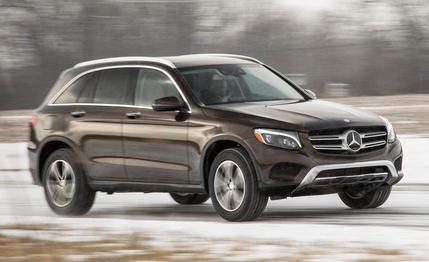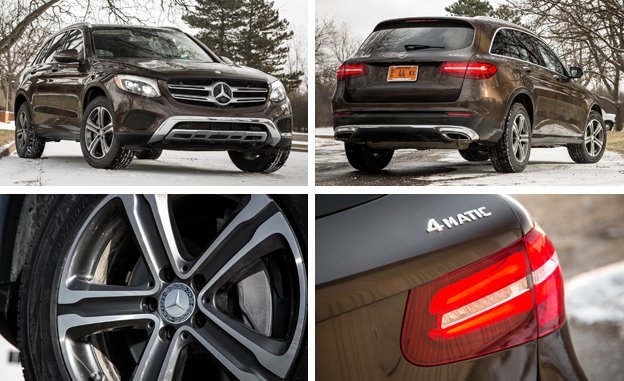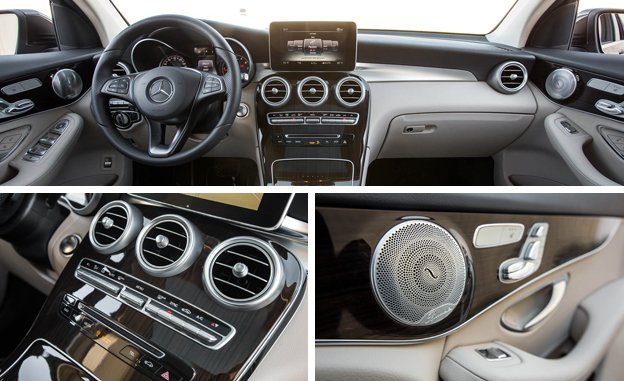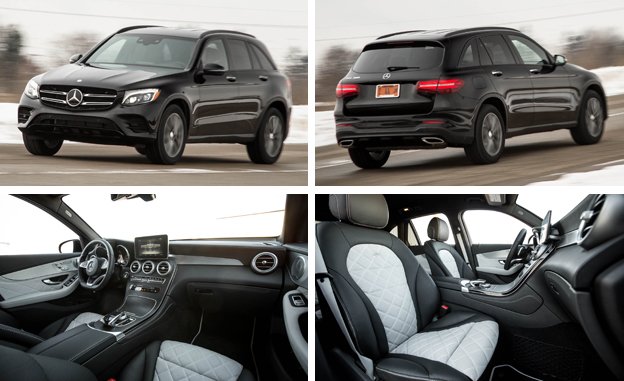 Instrumented Test
Instrumented Test
With crossover SUVs now outselling sedans, the latest Mercedes-Benz entry into the fast-growing compact segment seems destined to become the marque’s bestseller in short order. It’s been on sale since December, so you’ve probably already noticed these leather-lined shopping carts crowding your local Neiman Marcus and Whole Foods parking lots.
Stepping in for the former GLK-class for 2016, the new GLC-class moves onto the latest C-class platform and adopts the new Mercedes-Benz nomenclature. And a lot has changed besides the name. While it shares suspension and drivetrain hardware with the C-class sedan, the wheelbase and track width are greater. In all, the GLC300 measures 4.7 inches longer and 2.0 inches wider than its predecessor. A more commodious rear seat and expanded cargo hold are welcome benefits, and it all comes without the usual weight penalty. In fact, the GLC300 and the GLC300 4MATIC tested here weighed 275 and 128 pounds less than did the equivalent 2013 GLK models we tested nearly four years ago.

For the new model, we again tested both rear- and all-wheel-drive editions with the 2.0-liter turbocharged four-cylinder, which is the entire model range at present. The rear-driver is one of few in a class where opting out of AWD usually means settling for front-drive. Stuttgart intends to fill out this range with diesel, plug-in hybrid, and AMG high-performance editions in later model years, plus a hydrogen fuel-cell model and one of those crazy fastback “coupe” crossovers to face off against the BMW X4. While handsome and stylistically in tune with its sedan (and coupe) platform-mates, the GLC’s exterior profile hews more closely to class norms than did that of the distinctively squared-off, wagon-esque GLK. It’ll blend into the crowd in those shopping-center parking lots and carpool drop-off lanes, which might be a good thing for those who don’t want to feel ostentatious sliding a Benz in amongst the neighbors’ Kias and Hondas.
The drivetrain, too, reflects the current automotive hive-mind with yet another 2.0-liter four-cylinder turbo unit, rated at 241 horsepower. This supplants the GLK350’s 3.5-liter V-6, which made 302 horsepower. That power peak is fast becoming mundane for a turbo four of this size, matched by Kia, Ford, and Chevy among others. This turbo four’s 273 lb-ft of torque is identical to the rating of the former V-6, and the new car’s nine-speed automatic transmission has two more ratios to play with than did the GLK’s gearbox. An upshot is that EPA city ratings are up 3 mpg across the board, while the 28-mpg highway rating shared by both GLCs is up 3 and 4 mpg over the commensurate rear-drive and 4MATIC GLK models. Our observed fuel economy of 21 mpg with the 4MATIC and 24 with the rear-driver is 2 and 3 mpg better than we got in our test of the 2013 GLKs.
The turbocharged engine’s early-arriving torque helps the GLC300 get to 60 mph in 6.0 seconds (RWD) and 5.9 seconds (4MATIC), or just 0.3- and 0.1-second slower than did the V-6 GLK. Most of the competition hovers around 6.0 seconds, too, so this slight backsliding won’t be noticed except, perhaps, by those trading in a late-model GLK. The GLC also is slower to 100 mph (by a full 2.0 seconds), and the top-gear 30-to-50-mph and 50-to-70-mph times also increase by 0.3 to 0.7 second—those might have been worse but the nine-speed offers more optimal choices than could the old seven-cog transmission. The performance feels perfectly adequate in normal driving situations, though, and buyers in this segment who care are probably waiting on the AMG version, anyway.
Track figures that were more evident on the road include the improved braking performance, with 70-to-0-mph stops coming up in 166 and 174 feet, shorter by a significant 15 feet for the rear-drive model but only one foot for the 4MATIC. Skidpad roadholding of 0.84 g marks an improvement from 0.77 for the rear-driver, but the 4MATIC did 0.81, identical to its predecessor’s performance.

We’re told that Mercedes designers prevailed upon engineers for bigger wheels for the GLC, with 18-inchers now standard and both 19- and 20-inch upgrades offered. The GLC300 4MATIC had the 18s, wearing mud-and-snow-graded 235/60 Continental tires with a run-flat design. The rear-drive example had a lot more optional equipment, including the stylish, black AMG 20-inch wheels and Bridgestone Dueler summer rubber, size 255/45, which again were run-flats. Tire differences are no doubt reflected in the rear-drive car’s superior cornering and braking figures. Given how much easier it was to launch the 4MATIC car without excessive wheelspin, we suspect the acceleration gap might have been wider if both examples had the same tire.
The ride quality would have to be a lot creamier than it is to avoid the inadvertent reversals and setbacks that beset us when trying to use the COMAND system’s oversensitive touchpad, which manages the many features on the center-console screen. Best to use the rotary knob or do everything while parked or at least stopped—changing functions while on the move is distracting and often ends in cursing the system and abandoning the attempt. For this, you pay $2330? The Audi and BMW interfaces are better.
The Dynamic Select system that adjusts the car’s performance on an upward scale from Eco through Comfort and up to Sport+ marks useful distinctions and is much easier to manage. Other automated systems also work well—Mercedes-Benz’s Distronic Plus adaptive cruise control, part of the $2800 Driver Assistance package—may well set the industry standard, and its related driver aids always function as you’d expect.
One way that Mercedes achieved more cargo space with the GLC was by switching to run-flat tires. The GLK had an inflatable compact spare tire tucked under the cargo floor, but the GLC has none. This no doubt helps pare overall weight, but the stiff sidewalls and slightly heavier construction of run-flat tires increases the unsprung mass the suspension has to control. Our drivers noted a jarring response to some road irregularities. It was worse in the rear-drive example with the larger wheels, but even the 4MATIC surprised us with a sharp jolt or two. Both test cars had the standard, steel-spring suspension that we’ve preferred over the optional, air-spring AIRMATIC adjustable setup in the C-class sedan and coupe. With this wheel-and-tire package, though, there might be something to recommend the upgrade.

Although the premium price Mercedes-Benz commands for marketplace norms of engine specification and overall performance seems excessive, the interior design and appointments go some ways toward justifying the extra outlay. Especially in the rear-drive model equipped with $3950 worth of Designo-spec black-and-white nappa leather, ash wood trim, and a host of natty accents (ambient lighting, illuminated doorsills, top-stitched door-panel trim, etc.). Never underestimate the power of a little light to lift the mood of a Northerner struggling under the midwinter perma-cloud.
It’s also quiet inside and the steering, brakes, and transmission controls (once you get used to that weird little gear-selector wand) respond like well-balanced tools. Whereas the old GLK’s back seat was suitable for adults only for the quick dash to dinner, we could envision a long road trip in the aft compartment of the GLC. It would take only a little packing discipline to fit a weekend’s worth of luggage for two couples; discipline failing, there’s the roof rack.
The base MSRP on the rear-driver is $2000 lower than for the 4MATIC car, but once all the extras were added on, the bottom line tipped $2740 the other way. That Designo interior was the biggest difference. Both had the Driver Assistance package, Multimedia package (COMAND with navigation), Lighting package (full LED active headlamps with automatic high beams, $1500), and Premium package (keyless ignition, a 115-volt AC power outlet and satellite radio, $720). Both Monroneys also showed the stand-alone option of heated rear seats ($620); the Designo package includes heated/ventilated front seats, while the 4MATIC car had $580 heated front seats. They also shared Burmester audio ($850) and special-order heated windshield washers ($205). Only the 4MATIC had a $430 option for the power passenger seat with memory. The rear-drive model’s 20-inch-wheel package added $750, and it also had a $2950 Sport package (AMG body add-ons, MB-Tex coverings for the dash and door panels) and the $300 Night package (extensive black exterior trim, plus chrome tailpipes). Whew.
There’s more to be had, starting with the aforementioned $1900 Air Body Control, so it’s easy to push the sticker beyond $60,000, which if you ask us is a big stack of cash to drop on a 2.0-liter crossover. We fully expect the market will not agree and dealers will be fighting over their allocations.